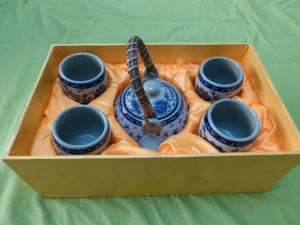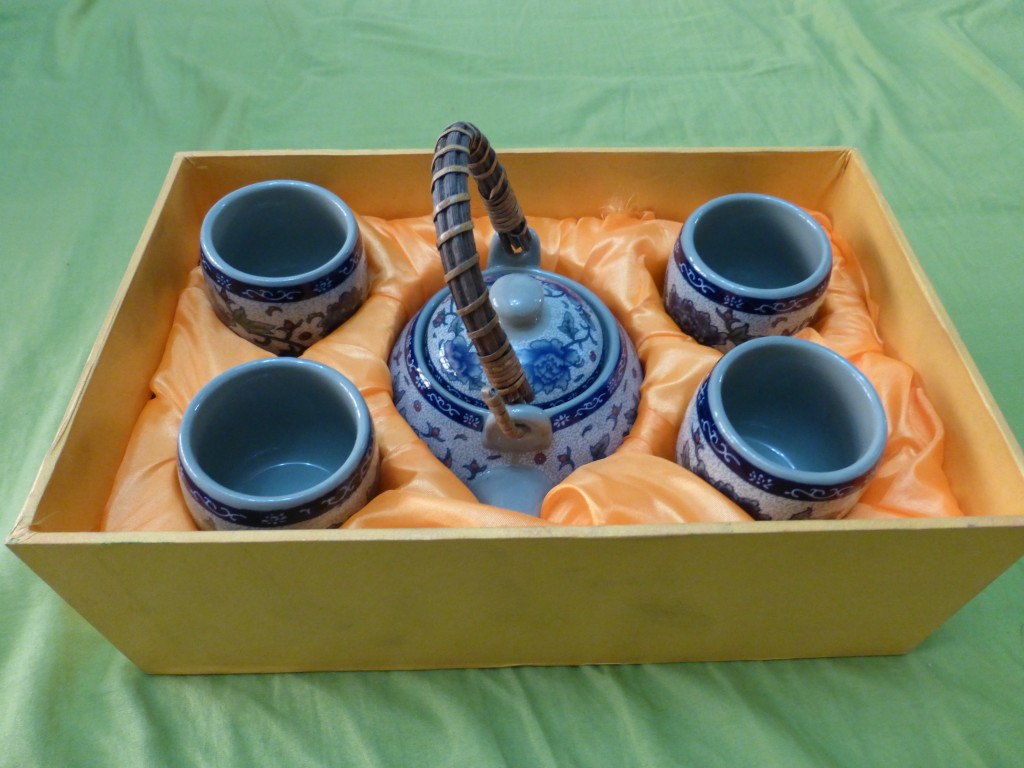
As in Morocco, tea has a deep cultural meaning for China. From parents discussing marriage arrangements to business deals of mega-millions to catching up with friends on a Sunday afternoon, personal and professional discussions are held throughout the country over small cups of various brews. Vice President Joe Biden even took part in a tea ceremony during his official visit to China last week.
If not in the tea houses, then you will find most people walking around with canisters of tea leaves, easily refillable with the many hot water dispensers found in offices, malls, train stations, airports and pretty much anywhere there is electricity. Read any travel book on China, and you’re sure to find mention of the Chinese people never far from one these flasks.
What does that have to do with the price of tea in China?
The history of tea in China is a convoluted one. Some accounts claim an ancient emperor was boiling drinking water on a particularly windy day when some foliage was blown into his cup. Not immediately removing the leaves, he discovered the tasty drink the mishap had created. For his book Oracle Bones, Peter Hessler interviewed a Chinese scholar, Victor Mair, in which the professor claims tea came from trading in the south, and that it was first viewed as a “barbarian drink … compare it to urine.” In the 15th Century, the famed British East India Company brought tea from China to England and eventually the New World.
Today, the tea business is a global industry worth billions of dollars. With research proving the wide array of health benefits and a developing taste worldwide, tea consumerism is on the rise.
Coming from the Camellia sinensis bush, the leaf buds of the plant are harvested in the spring and fall. The spring harvest is considered more valuable and organic. The buds are then used to make six types of Chinese tea:
1. White
The most delicate of the flavors, white tea comes from the soft fur still on the young tea leave buds. The leaves come from Fu Ding, a high and rocky environment where the fermentation is a sun-dried process. This tea can only be infused up to two times. Health benefits include use as a anti-inflammatory and a deterrent in cognitive diseases.
2. Green
Green tea is produced by roasting the leaves, oxidizing the flavor through direct contact with a heat source. The leaves come from An Ji, best known as the beautiful area of Yellow Mountain. Depending on the length of the oxidization process, the tea can have a nutty, fruity or floral flavor. The leaves can be infused up to four times. Green tea is believed to lower risks of cancer, osteoporosis and depression.
3. Yellow
The hardest of the teas to acquire, yellow tea comes from Huo Shan. The tea is roasted at higher temperatures than green tea and is pressurized. Providing a citrus flavor, this tea can be infused up to 15 times. Yellow tea is used as an aid in digestion.
4. Wu Long
Roasted on fire than twisted, wu long tea leaves endure a harsher oxidation process. This tea is used in the most formal Chinese tea ceremony and produces a more bitter floral taste. It can be infused up to eight times.
5. Red/Black
The strongest of the flavors, red/black tea is what is most familiar for Westerners. Produced by companies such as Lipton, this tea is seeped excessively and creates a bitter taste.
6. Dark
The most fermented, therefore the most flavorful and valuable of the teas, dark tea comes from the Hunan Province. With a strong astringent taste, this tea is drank after especially heavy or greasy meals for its digestion benefits. Infusion can take place up to 20 times. Dark tea is believed to lower blood pressure and cholesterol levels.
Mastering a Chinese tea ceremony
Sponsored by the Shanghai Expatriate Association, I recently attended a traditional Chinese tea ceremony with the Shanghai & Beyond tour agency at the Moonlight Tea House. Our guides, Tracy Lesh and Michael Wang, have been running tours about Chinese tea culture and water towns for the past several years. They enlisted the help of a local tea shop owner who had studied tea and the art of the ceremony at university to serve as the la shu gung fu or “skilled teacher” for the event.
As we were seated, the tea shop owner stood at the head of the long table behind her tea set. She wore no makeup, jewelry or perfume as any of these could potentially taint the smell or flavor of the tea. She bowed and welcomed us in Chinese to the ceremony. She then took her seat and began bringing her instruments, the tea pot and cups, to a temperature accommodating to a gentle seep. Unlike in the West, Chinese tea is not meant to seep long, only enough to open the buds and release the flavor.
The teacher first heated the purified water to a temperature of about 80 degrees Celsius, as most of the teas don’t need to be seeped any hotter (another mistake we make in the West). During the ceremony, we tried five of the six types of tea, only excluding the red/black category. The la shu gung fu started with the white tea and moved down the list, ending with the dark tea.
As each gesture is beautifully coordinated, the teacher demonstrated “orchard fingers,” the flowing hand movements she used to prepare the tea without ever touching the leaves. It was as if she was performing a ballet with her hands.
Video courtesy of Annie Kim
After the first batch of each tea was made, she would discard it as this is not meant to be consumed but just used to open up the leaves. The leaves are then re-infused for the sampling.
To drink, etiquette dictates that you hold the small cup by the thumb and forefinger, using the middle finger to support the bottom. Ladies are expected to use their left hand to cover the cup while you sip. Like wine, drinking the tea is a three-step process:
1. Slurp the tea in while you take air into your mouth. This helps oxidize the tea.
2. Hold it in your mouth while you roll your tongue. This allows all of your taste buds to experience the tea.
3. Swallow.
After we finished the samples, the la shu gung fu then stood, bowed and wished us great health to conclude the ceremony.
Your own Chinese tea ceremony
How do you like your tea? For the first worktrotter to leave a comment below by Dec. 31, I’ll send you a package of green tea. Cheers to you!
-Monica


This looks like a great experience! My first experience with a formal tea was this past August at the famous “Afternoon Tea” at The Empress Hotel in Victoria, British Columbia in Canada. I wasn’t sure what to expect and feared it would be a little too commercial, but it was a fun experience. I recommend it for a special occasion.
I love sweet tea!
The fluidity and precision of her movements to be almost entrancing. Such a beautiful ceremony and who knew I was missing out on so many varieties of teas and natural cures for all those ailments. Lucky girl enjoy your travels. Thanks for sharing your adventure.
I LOVE tea! Green tea – just plain; regular tea – hot, with milk and sugar, or sweet tea!
I miss you, friend!
Thanks to everyone for sharing your tea preference. Congratulations to Jay for being the first the comment, win the tea, and presenting his final project yesterday for his Communications Management degree at Syracuse University. You did a great job, Jay, and I hope you and Ken enjoy the tea!
Hi, Chris
I am a huge fan of your site. I am really enjoying your posts, especially this post: https://www.working2live.com/chinese-tea-ceremony/
Very detailed and valuable information. It helps me a lot.
In this post, it has mentions Chinese tea and Chinese tea set.
There are various categories of Chinese tea sets. Being of elegant styles, practical use and artistic value, they are well-known around the world and favored by tea lovers throughout history
I know you’re busy, so I won’t waste your time. I’m reaching out because I have an idea share to you. I am doing a research about Chinese Tea Sets and planning to write a post about it, can you kindly just provide me few tips and guidance about it? By the way, I am the owner of Umi Tea Sets Store. I am Chinese. Our store have many exquisite Chinese Tea Sets, I have picked a handmade quality Chinese Teapot and sent to you as gift, it come with a gift box. It is totally free, hope you can accept my first gift, and hope we can become friend. so we can talk more about it next.
Or if you like, we have few high quality blogs for you to post the topic you like and link to your site, and our official FB, Pinterest and Ins account has over 1000 followers, we can share your site to them. To let them know your wonderful posts.
I would love to hear from you and find a way to have our brands work together! Also, if there’s a fee associated for your time we completely understand and we’re happy to discuss that as well!
Cheers,
Umi Tea Sets